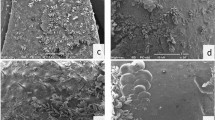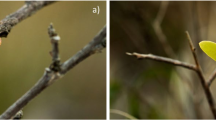Abstract
Key message
The epiphyte Tillandsia recurvata modifies the anatomy of the xylem, phloem and periderm of its host Prosopis laevigata, these modifications affect water flux and photosynthetic activity in this host.
Abstract
The relationships between epiphytes and host plants are commensal interactions, where epiphytes obtain support to growth without damaging their hosts. However, some epiphytes may cause the death of branches in their hosts. Ball moss (Tillandsia recurvata) is an epiphyte with elevated reproductive success in semiarid zones of México, growing mainly on mesquite trees (Prosopis laevigata). Mesquites are of great ecological and economical importance in central and northern Mexico, but the elevated mortality of branches and even whole trees have been associated with high ball moss loads. This study evaluates whether ball moss causes structural damage in the phloem, xylem, and periderm of mesquite branches, also testing whether the physiological performance of these branches was reduced. For this we measure the effective quantum yield of photosystem II (ΦPSII), hydraulic conductivity, water flux, number of vessels and the effective area of conduction in mesquite branches with and without ball moss. The results demonstrated that juvenile ball moss only affected the periderm and the collapsed phloem with no damage to non-collapsed phloem or xylem, but the reproductive individuals modified the anatomy of the xylem, phloem and periderm of mesquite. These structural modifications affected both water flux and hydraulic conductivity and reduced the ΦPSII. Our findings suggest that structural and ecophysiological changes induced by the ball moss are the cause of high branch mortality in mesquite. This is the first study showing anatomical and ecophysiological evidence of an epiphytic plant damaging its host.




Similar content being viewed by others
References
Aguilar-Rodríguez S, Terrazas T, Aguirre-León E, Huidobro-Salas ME (2007) Modificaciones en la corteza de Prosopis laevigata por el establecimiento de Tillandsia recurvata. Bol Soc Bot Méx 81:27–35. https://doi.org/10.17129/botsci.1763
Aguilar-Rodríguez S, Terrazas T, Huidobro-Salas ME, Aguirre-León E (2016) Anatomical and histochemical bark changes due to growth of Tillandsia recurvata (ball moss). Bot Sci 94:551–562. https://doi.org/10.17129/botsci.531
Almanza SG, García-Moya E (1986) The uses of mesquite (Prosopis spp.) in the highlands of San Luis Potosi. Mexico Forest Ecol Manag 16:49–56. https://doi.org/10.1016/0378-1127(86)90007-1
Benzing DH, Seeman J (1978) Nutritional piracy and host tree decline: a new perspective on the epiphyte-host relationship. Selbyana 2:133–148
Benzing DH (1990) Vascular epiphytes: general biology and related biota. Cambridge University Press, Cambridge
Bernal R, Valverde T, Hernández-Rosas L (2005) Habitat preference of the epiphyte Tillandsia recurvata (Bromeliaceae) in a semi-desert environment in Central Mexico. Botany 83:1238–1247. https://doi.org/10.1139/b05-076
Brige WI (1911) The anatomy and some biological aspects of the “ball moss”, Tillandsia recurvata L. Bul Univ Tex 194:1–24
Burkart A (1976) A monograph of the genus Prosopis (Leguminosae subfam. Mimosoideae). J Arnold Arbor 57:450–525
Chano V, López R, Pita P, Collada C, Soto Á (2015) Proliferation of axial parenchymatic xylem cells is a key step in wound closure of girdled stems in Pinus canariensis. BMC Plant Biol 15:64. https://doi.org/10.1186/s12870-015-0447-z
Chaves CJN, Dyonisio JC, Rossatto DR (2016) Host trait combinations drive abundance and canopy distribution of atmospheric bromeliad assemblages. AoB Plants 8:plw010. https://doi.org/10.1093/aobpla/plw010
Cortes-Anzures BO, Corona-López AM, Toledo-Hernández VH, Valencia-Díaz S, Flores-Palacios A (2017) Branch mortality influences phorophyte quality for vascular epiphytes. Botany 95:709–716. https://doi.org/10.1139/cjb-2017-0023
Espino S, Schenk J (2011) Mind the bubbles: achieving stable measurements of maximum hydraulic conductivity through woody plant samples. J Exp Bot 62:1119–1132. https://doi.org/10.1093/jxb/erq338
Flores-Palacios A, Barbosa-Duchateau CL, Valencia-Díaz S, Capistrán-Barradas A, García-Franco JG (2014) Direct and indirect effects of Tillandsia recurvata on Prosopis laevigata in the Chihuahuan Desert scrubland of San Luis Potosi, Mexico. J Arid Environ 104:88–95. https://doi.org/10.1016/j.jaridenv.2014.02.010
Flores-Palacios A, García-Franco JG, Capistrán-Barradas A (2015) Biomass, phorophyte specificity and distribution of Tillandsia recurvata in a tropical semi-desert environment (Chihuahuan Desert, Mexico). Plant Ecol Evol 148:68–75. https://doi.org/10.5091/plecevo.2015.874
García-Franco JG, López-Portillo J, Ángeles G (2007) The holoparasitic endophyte Bdallophyton americanum affects root water conductivity of the tree Bursera simaruba. Trees 21:215–220. https://doi.org/10.1007/s00468-006-0113-z
Genty B, Briantais JM, Baker NR (1989) The relationship between the quantum yield of photosynthetic electron transport and quenching of chlorophyll fluorescence. Biochim Biophys Acta 990:87–92. https://doi.org/10.1016/S0304-4165(89)80016-9
Maxwell K, Johnson GN (2000) Chlorophyll fluorescence — a practical guide. J Exp Bot 51:659–668. https://doi.org/10.1093/jxb/51.345.659
Medina GG, Díaz PG, Loredo OC, Serrano AV, Cano GMA (2005) Estadísticas climatológicas básicas del estado de San Luis Potosí. INIFAP-Centro de Investigación Regional Noreste, México, D.F.
Melcher PJ, Goldstein G, Meinzer FC, Yount DE, Jones TJ, Holbrook NM, Huang CX (2001) Water relations of coastal and estuarine Rhizophora mangle: xylem pressure potential and dynamics of embolism formation and repair. Oecologia 126:182–192. https://doi.org/10.1007/s004420000519
Melcher PJ, Holbrook NM, Burns MJ, Zwieniecki MA, Cobb AR, Brodribb TJ, Choat B, Sack L (2012) Measurements of stem xylem hydraulic conductivity in the laboratory and field. Methods Ecol Evol 3:685–694. https://doi.org/10.1111/j.2041-210X.2012.00204.x
Montaña C, Dirzo R, Flores A (1997) Structural parasitism of an epiphytic bromeliad upon Cercidium praecox in an intertropical semiarid ecosystem. Biotropica 29:517–521
Navar J, Rodriguez-Flores FJ, Rios-Saucedo J (2019) Biomass estimation equations for mesquite trees in the Americas. PeerJ 7:e6782. https://doi.org/10.7717/peerj.6782
Nilsen ET, Sharifi MR, Rundel PW, Jarrell WM, Virginia RA (1983) Diurnal and seasonal water relations of the desert phreatophyte Prosopis glandulosa (honey mesquite) in the Sonoran Desert of California. Ecology 64:1381–1393. https://doi.org/10.2307/1937492
Páez-Gerardo LE, Aguilar-Rodríguez S, Terrazas T, Huidobro-Salas ME, Aguirre-León E (2005) Cambios anatómicos en la corteza de Parkinsonia praecox (Ruiz et Pavón) Hawkins causados por la epífita Tillandsia recurvata L. (Bromeliaceae). Bol Soc Bot Méx 77:59–64. https://doi.org/10.17129/botsci.1713
Pérez-Noyola FJ, Flores J, Yáñez-Espinosa L, Jurado E, De La Rosa-Manzano E, Badano E. (2020) Complete vivipary behavior detected in the epiphytic Tillandsia recurvata L. (Ball moss) in the Chihuahuan Desert in two continuous years. J Arid Environ 174:103993. https://doi.org/10.1016/j.jaridenv.2019.103993
Puente ME, Bashan Y (1994) The desert epiphyte Tillandsia recurvata harbours the nitrogen-fixing bacterium Pseudomonas stutzeri. Can J Bot 72:406–408. https://doi.org/10.1139/b94-054
Ruiz-Nieto JE, Hernández-Ruiz J, Hernández-Marín J, Mendoza-Carrillo J, Abraham-Juárez M, Isiordia-Lachica PM, Mireles-Arriaga AI (2020) Mesquite (Prosopis spp.) tree as a feed resource for animal growth. Agroforest Syst. https://doi.org/10.1007/s10457-020-00481-x
Salazar PC, Navarro-Cerrillo RM, Grados N (2019) Tree size and leaf traits determine the fertility island effect in Prosopis pallida dryland forest in Northern Peru. Plant Soil 437:117–135. https://doi.org/10.1007/s11104-019-03965-7
Sáyago R, Lopezaraiza-Mikel M, Quesada M, Álvarez-Añorve MY, Cascante-Marín A, Bastida JM (2013) Evaluating factors that predict the structure of a commensalistic epiphyte–phorophyte network. Proc R Soc Lond B Biol Sci 280:20122821. https://doi.org/10.1098/rspb.2012.2821
Soria NF, Torres C, Galetto L (2014) Experimental evidence of an increased leaf production in Prosopis after removal of epiphytes (Tillandsia). Flora 209:580–586. https://doi.org/10.1016/j.flora.2014.08.007
Sperry JS, Donnelly JR, Tyree MT (1988) A method for measuring hydraulic conductivity and embolism in xylem. Plant Cell Environ 11:35–40. https://doi.org/10.1111/j.1365-3040.1988.tb01774.x
Stanton DE, Huallpa-Chávez J, Villegas L, Villasante F, Armesto J, Hedin LO, Horn H (2014) Epiphytes improve host plant water use by microenvironment modification. Funct Ecol 28:1274–1283. https://doi.org/10.1111/1365-2435.12249
Stevens GC (1987) Lianas as structural parasites: the Bursera simaruba example. Ecology 68:77–81. https://doi.org/10.2307/1938806
Teixeira-Costa L, Ceccantini G (2015) Embolism increase and anatomical modifications caused by a parasitic plant. IAWA J 36:138–151. https://doi.org/10.1163/22941932-00000091
Tiedemann AR, Klemmedson JO (1973) Nutrient availability in desert grassland soils under mesquite (Prosopis juliflora) trees and adjacent open areas. SSSA J 37:107–111. https://doi.org/10.2136/sssaj1973.03615995003700010033x
Vergara-Torres CA, Pacheco-Álvarez MC, Flores-Palacios A (2010) Host preference and host limitation of vascular epiphytes in a tropical dry forest of central Mexico. J Trop Ecol 26:563–570. https://doi.org/10.1017/S0266467410000349
Zajaczkowska U (2014) Regeneration of Scots pine stem after wounding. IAWA J 35:270–280. https://doi.org/10.1163/22941932-00000065
Acknowledgements
F.J. Pérez-Noyola was sponsored by CONACYT (296804) for his Postgraduate studies. We thank J. P. Rodas Ortiz for his help in field work and D. García-Martínez for her help in lab work. We also thank Puebla Hernández family for their hospitality at their ranch.
Funding
Authors would like to thank the National Council of Science and Technology (CONACYT) (Awards CB-2010–156205, FORDECYT–CONACYT 296354 and PAICYT-UANL) for providing the financial support.
Author information
Authors and Affiliations
Corresponding author
Ethics declarations
Conflict of interest
The authors declare that they have no competing interests.
Additional information
Communicated by A. Franco.
Publisher's Note
Springer Nature remains neutral with regard to jurisdictional claims in published maps and institutional affiliations.
Rights and permissions
About this article
Cite this article
Pérez-Noyola, F.J., Flores, J., Yáñez-Espinosa, L. et al. Is ball moss (Tillandsia recurvata) a structural parasite of mesquite (Prosopis laevigata)? Anatomical and ecophysiological evidence. Trees 35, 135–144 (2021). https://doi.org/10.1007/s00468-020-02023-5
Received:
Accepted:
Published:
Issue Date:
DOI: https://doi.org/10.1007/s00468-020-02023-5




